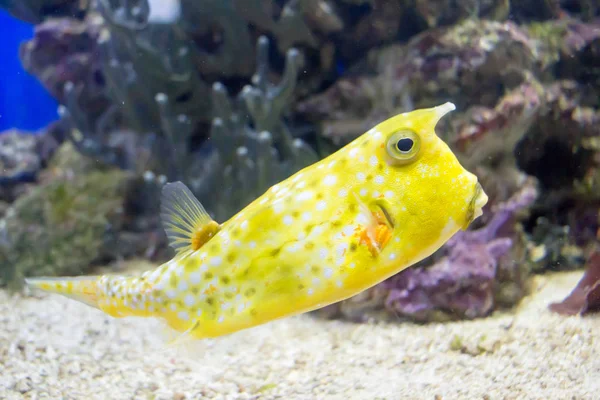Longhorn Cowfish are saltwater creatures that can be found throughout the Indo-Pacific. They appear yellow, box-shaped, and have horns on each side of their face and rear.
If adequately cared for, cowfish can survive an extended period, especially if kept in a household tank. Cowfish in captivity have an approximate 16 inches height and a maximum height of 20 inches in their native environment. But how long do cowfish live – really?
Cowfish kept in confinement cannot live as long or reach the height of a wild cowfish. However, the average longhorn cowfish lifespan is quite good, even if kept in captivity. Cowfish can last anywhere between 2 to 8 years as pets.
Additionally, you should be aware that these creatures are unsuitable for amateur or moderate caretakers; nevertheless, you should know cowfish facts and caring tips if you’re up for taking care of cowfish.
A Quick Overview On Cowfish
The cowfish’s color palette varies from yellow to brown, having blue and white tiny dots. In addition, they might feature a deep brown to black sheen surrounding their mouth and eyes. Brown spots can also be detected throughout their body.
The horns that emerge from each side of the Longhorn cowfish’s skull and rear are the fish’s most distinguishing feature. Young or baby fish are more likely to have horns, and they get smaller as the fish mature. It is said so because horns are obtained naturally through birth to make bigger fishes extremely challenging to feed. As cowfish get older, being attacked declines, and horns get less important; hence, smaller horns are better.
Longhorn cowfish also have eyeballs that look milk-like and a multicolored epidermis. These fish have these kinds of eyes due to a major brown pigment known as corneal iridenses.
It’s a barrier of epithelium that prevents sunlight from coming directly above, allowing fish to munch on deep ocean live rock. It gives the eye-catching bluish pupillary quality, which is identical to milk-like pictures!
Cowfish, for example, lack pelvic fins, appear scaleless, and do not feature fins around their spinal region. They are also more vulnerable to infection and pathogens due to their lack of scales. As a result, one must exercise extreme caution when it comes to water quality. As a result of their rigidity and oddly distinctive body form, they appear to be floating whenever they are actually swimming.
Average Longhorn Cowfish Lifespan

Longhorn cowfish dwell for an average of 8 years inside the dark blue sea. Wild cowfish have been known to survive up to 10 years within their natural environment, where they could maintain their optimal rate of energy and expand to a full length of 20 inches.
However, cowfish in confinement cannot thrive as much or expand as large as they will in their natural habitat.
In addition, numerous aspects, like tank conditions, diet, and stress patterns, could impact the cowfish’s overall lifetime, just as they might with any other fish.
How Can You Increase Your Cowfish’s Lifespan?
If you are wondering how to increase the lifespan of your cowfish, you should first learn the important characteristics that impact how long your pet cowfish will generally live.
Aquarium Conditions
Longhorn cowfish are seawater species; therefore, the circumstances in your tank must be similar to how they would experience in the sea. They require a steady temperature of 72 to 80 degrees F as well as a pH of 8.1 to 8.4., dKH 8-12, and sg 1.020-1.025.
They also need an aquarium with approximately 150 gallons, although typically 250 gallons, provided you have the proper area where it could be securely placed. Ensure that the water is still since they are not particularly safe in rough settings.
Tankmates For Cowfish
Furthermore, the cowfish is a calm and easygoing fish that prefer similar types of species with the same characteristics. As a result, the shorter and less dangerous the fish, the ideal their match would be.
They can discharge a destructible quantity of toxin when disturbed and provoked, resulting in a life-threatening and unfortunate tragedy. Cowfish are also not tolerant of its poison; thus, they might die as well. Inside the Indo-Pacific region, creatures including seahorses, various boxfish, and even pipefish are common, and these animals are not harmful to cowfish in any manner.
Nutrition
Generally, cowfish are not fussy eaters; therefore, you may feed them a variety of species such as algal fish, miniature shrimp, live snails, and sometimes even small fish in addition to their daily healthy meals that you normally feed 2 to 3 times per day.
Longhorn cowfish contain fangs that are continuously developing, just like other fish of its family. To keep their dentures from getting too big, they have to munch on tougher things such as living snails and prawns every once in a while.
Stress Levels
If you would like to increase the life expectancy of a longhorn cowfish, keep in mind to keep your fish’s stress levels relatively low. With the longhorn cowfish, excessive stress is not just bad for the health, but it could even be deadly.
Whenever longhorn cowfish is agitated, it will emit an ichthyocide toxic substance known as ostracitoxin. So, is the cowfish poisonous? Yes, not only will the toxin kill the cowfish, but it will also destroy the rest of the species in your aquarium. It makes caring for cowfish even more challenging because you have to monitor your fish as much as possible.
Conclusion
Longhorn cowfish are a magnificent, one-of-a-kind fish that can be challenging to manage for beginners. They may survive approximately 8 years in confinement if properly cared for.
If you are looking for ways to extend the life expectancy of your favorite fish, be prepared to preserve its tank in good shape, feed it plenty of nutritional food, and try to keep it in a calm and stress-free environment.

